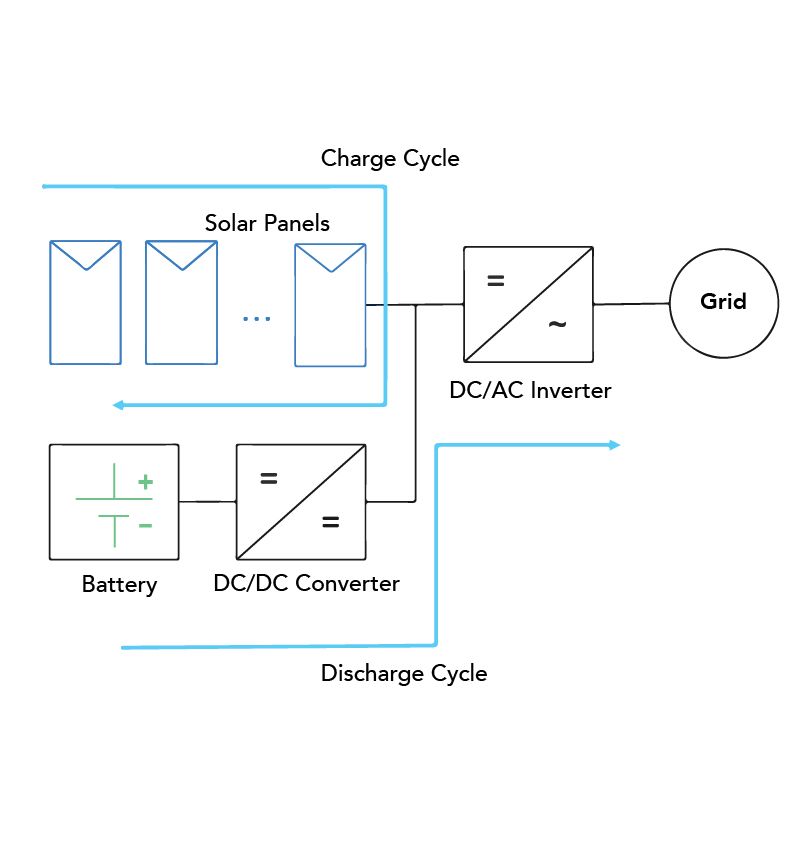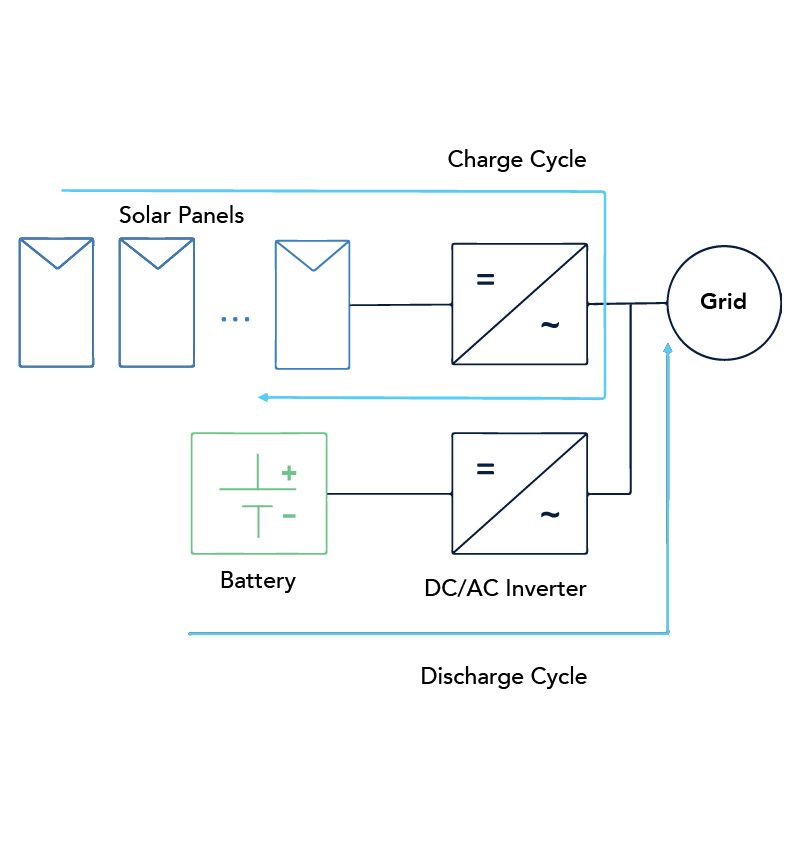
Adding energy storage to existing renewable energy assets
Between 2009 and 2019, approximately 155 GW of renewable energy capacity—specifically solar and wind power projects—have been installed through the United States. Projects have been installed on both the transmission (utility-scale) and distribution (distributed energy) systems across the country. Historically, these assets have not included a Battery Energy Storage System (BESS). However, with the reduction in capital cost and the increased industry focus on the reduction of greenhouse gas emissions and stability in the electrical grid, owners are seeking to add a BESS to existing projects.
Here are the top technical and commercial factors to consider in evaluating the addition of a BESS to an operational asset.
Technical considerations
Key technical considerations include the coupling method for integration with existing solar assets. And for solar or wind assets, it is important to evaluate available BESS technology and alignment with anticipated use cases, as well as impacts to interconnection arrangements or queue position modification that may be necessary.
Coupling methods
One of the first technical factors required to understand the implications of adding a BESS to an existing solar asset is whether to integrate the BESS on the alternating current (AC) or direct current (DC) side of the system. Figures 1A and 1B show the notional addition of a DC- or AC-coupled BESS to a solar array. For wind assets, BESS must be AC-coupled given the AC output of the wind turbines.

Figure 1A: Utility-scale PV installation with DC-coupled BESS

Figure 1B: Utility-scale PV installation with AC-coupled BESS
DC-coupled
In a DC-coupled configuration, the solar array and the BESS are connected on the same DC bus and use the same power conversion system (PCS) to convert from DC to AC current. A DC/DC converter is added between the solar array and the batteries for converting the DC voltage of the solar array to match the DC voltage needed to charge the batteries. This allows the BESS to be charged directly from the solar system, which eliminates the efficiency losses when electricity is converted from DC to AC and vice versa. The BESS can also be charged via backfeed from the transmission or distribution system if a bidirectional PCS is utilized.
AC-coupled
In an AC-coupled configuration, there are two PCSs for solar or wind assets: one for the renewable energy source and another for the BESS. In this arrangement, the BESS can be charged either via backfeed from the transmission or distribution system or via the renewable energy source. In the case of solar, for the BESS to be charged from the solar array, the electricity must be converted from DC to AC at the solar PCS and then from AC to DC at the BESS PCS.
Technical feasibility
Each individual project must be examined to determine the technical feasibility and revenue opportunities of either option. With a DC-coupled addition, existing inverters may not be capable of integrating with a BESS and may require modification or replacement. Also, space may be limited in the solar arrays to install BESS enclosures. On the other hand, with an AC-coupled addition, the technical feasibility depends on the existing configuration of the medium-voltage (MV) or high-voltage substation or related infrastructure, as well as available space. As an example, some projects may have space for a new 34.5 kV breaker position as well as the BESS components required, without much modification. Other projects may require re-engineering of the existing infrastructure to accommodate the addition of the BESS system. These factors must be considered when weighing the upfront capital cost and schedule implications of the coupling approach.
Technology selections
It is important to understand the anticipated use case for the BESS once integrated with the wind or solar asset in order to make selections around battery chemistries and system sizing. BESS are typically provided by a specialized “integrator” and sold with the following equipment:
Additional BESS integrator diligence areas include general installation experience and experience with brownfield installations; typical BESS design and ability to support desired use cases; approach to supplier qualification; certifications and approach to safety; historical field performance; and provisions in the standard warranty and performance guarantees. It is important to confirm alignment between desired use cases, BESS operational capability, interconnection and offtake requirements, and performance guarantees while selecting a BESS integrator and negotiating commercial terms.
During the procurement process, solicitations from both BESS integrators and engineering, procurement, and construction (EPC) contractors are likely to be required. Often BESS integrators and EPC contractors share installation and commissioning scope to realize a BESS project. Coordination between the BESS integrator and balance of plant EPC contractor and clear division of responsibility is needed to ensure a smooth BESS installation. Both entities require full design sets for the existing project to make proposals outlining the necessary scope of work to incorporate the desired BESS configuration into the existing project infrastructure.
Queue position modification
Once a decision is made regarding the decision to DC-couple or AC-couple the BESS, the next step is to notify the respective utility and/or regional transmission operator (RTO), or independent system operator (ISO), as applicable. These notifications are made in the form of a new interconnection request or a modification to the existing queue position, depending on the circumstance.
Post FERC Order 845, many utilities offer a surplus interconnection option to add BESS component to existing generator projects as long the total injection at the POI remains the same and the BESS component is charged from the on-site generator resource. The utility and/or ISO/RTO typically study the impacts to the respective systems regarding the addition of the BESS and approve the request. If no material impacts are assessed, the surplus request is approved and the interconnection agreements are amended suitably.
In general, a DC-coupled BESS addition to an existing project is least likely to result in any material impacts and/or require an extensive study process with the potential for manifestation of system upgrade costs. An AC-coupled solution, depending on the intended use case, may have a higher likelihood of requiring network mitigations by the respective utility and/or ISO/RTO since the uses cases more commonly call for charging from the grid. However, the likelihood of such a situation depends on many factors, including the extent of work required to accommodate the BESS.
Commercial considerations
In addition to evaluation of technical feasibility, key commercial implications that merit consideration include the investment tax credit and revenue opportunities for the integrated BESS.
Investment tax credit (ITC)
The majority of energy storage information provided by the internal revenue services (IRS) has been a result of private-letter rulings that are only binding to the taxpayer who received it and are not precedent. However, some of those rulings are summarized below.
- PLR 201308005: The IRS ruled that a commercial, behind-the-meter battery included in the original installation of a solar system will be considered part of the “energy property” and the ITC could be claimed on its full cost if 75% of the energy stored in the device during the previous annual period were from a renewable resource. The ITC may be reduced pro-rata for any amount less than 100% but greater than 75%.
- PLR 201809003: The IRS ruled that an energy storage device installed one year after installation of the original solar system could apply.
- The energy storage system must also be “in-close proximity” and under common ownership by the same taxpayer filing for the solar ITC.
DC-coupled systems simplify capture of solar ITC because solar energy (DC electricity) can flow directly into the BESS. Typically, DC-coupled systems do not charge from the grid. The bi-directional inverter will only be able to support one operation at a time, either discharge photovoltaics (PV) to the grid or charge the BESS from the grid.
For the ITC credit, compliance is required for the first five years of service and 75% of all energy stored must come from a renewable energy source. With proper metering, controls, and an energy management system capable of logging all charging activity, the BESS can be monitored and controlled to ensure it does not capture more than 25% of charged capacity from the grid. The ITC credit will be prorated and applied to the portion of the energy charged from the renewable energy source only. For example, a 100 MWh battery charging 75% from a renewable energy source will only get 75% of the full ITC. As a result, it is typical that BESS charging occurs 100% from the renewable energy source in the first five service years to fully capture the tax credits.
Capture of additional revenue from the BESS
Perhaps the most important factor impacting the decision to add a BESS to an existing renewable energy project is the additional revenue opportunities that may be gained from making such an addition. These opportunities may vary based on the commercial structure of the asset:
DC-coupled
For DC-coupled systems, the most common application is to capture solar energy that is otherwise “wasted” during each of the following events: 1) mid-day inverter clipping or 2) curtailment from the utility. While clipping is a much more common example presently, curtailment has been increasing significantly in some areas of the country with high renewable penetration and may become an increasingly important attribute of BESS systems in the future. A DC-coupled BESS can mitigate this impact by using the clipped or curtailed energy to provide charging energy to the batteries. In the later afternoon, as irradiance is reduced, that same energy can then supplement the falling solar output to maintain full output of the system for longer. As an example, projects with a PPA may be able to capture the sale of that additional energy that was previously being “discarded.”
AC-coupled
While the attributes associated with DC-coupled systems are valuable, AC-coupled systems open the door to many other revenue opportunities. Projects participating in wholesale electricity markets are best positioned to take advantage of these use cases. Some examples of these may be energy arbitrage (where power is purchased during “cheap” times to charge the BESS, and discharged during more “expensive” times, with the project booking the difference as profit) and ancillary services (such as frequency regulation, or spinning reserves).
Final thoughts
The decision to add a BESS to an existing renewable energy project should include a close examination of all relevant factors, such as the decision to DC- or AC-couple. Other factors to consider include the existing project’s ability to accept either configuration, potential distribution or transmission system impacts, capital cost and tax implications, and commercial or additional revenue opportunities. Understanding these factors will help make the decision easier.